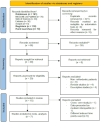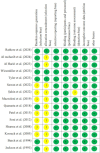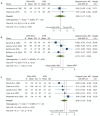The effectiveness of oral irrigators on periodontal health status and oral hygiene of orthodontic patients: a systematic review and meta-analysis
- PMID: 39633346
- PMCID: PMC11619677
- DOI: 10.1186/s12903-024-05255-w
The effectiveness of oral irrigators on periodontal health status and oral hygiene of orthodontic patients: a systematic review and meta-analysis
Abstract
Background: An Oral irrigator, known as a dental waterjet (DWJ), is an adjunctive oral hygiene tool to remove dental plaque. The aim of this study was to systematically evaluate the effectiveness of oral irrigators on orthodontic patients' oral hygiene and periodontal status.
Methods: A comprehensive search was undertaken in five electronic databases (PubMed, EMBASE, Web of Science, Scopus, and Cochrane) up to 1 May 2024. Clinical trials comparing DWJ with other adjunctive tools or no adjunctive in healthy orthodontic patients were included. The outcome was periodontal health condition measured by periodontal indexes. The risk of bias of the included studies was assessed using the Cochrane risk of bias tool. Random- effects meta- analyses of mean differences (MD) with their 95% confidence intervals (CI) were conducted and the overall quality of evidence was evaluated by GRADE approach.
Results: Seven trials were included in the meta-analysis (Two with low, and others with unclear risk of bias). There was no statistically significant difference between automatic toothbrush (ATB) with DWJ and ATB alone in the gingival index (GI) (MD = 0.00; 95% CI -0.17- 0.18) (low quality of evidence). No statistically significant differences were found between (ATB + DWJ) and manual toothbrush (MTB) alone in the GI (MD= -0.11; 95% CI -0.31- 0.09) (very low quality of evidence). Also, no significant difference was detected between the two groups in the Plaque index (PI) (MD= -0.12; 95% CI -0.36- 0.11) (very low quality of evidence). There was no statistically significant difference between (MTB + DWJ) and MTB alone in the GI (MD= -0.06; 95% CI -0.16- 0.03) (very low quality of evidence). No statistically significant differences were revealed between the two groups in the PI (MD= -0.33; 95% CI -0.97- 0.32) (very low quality of evidence). No statistically significant improvements were found between these two groups in bleeding index (BI) (MD= -0.05; 95% CI - 0.12 - 0.01) (low quality of evidence).
Conclusions: Adding DWJ to either manual or automatic toothbrushes did not significantly enhance oral health of orthodontic patients. Orthodontists could recommend their patients to use either of these toothbrushes with or without DWJ. Further clinical trials are needed.
Trial registration number: The protocol of this study was registered on PROSPERO with the ID # CRD42023465849.
Keywords: Dental Plaque; Dental Water jet; Meta-analysis; Orthodontics; Periodontal Index.
© 2024. The Author(s).
Conflict of interest statement
Declarations. Ethics approval and consent to participate: Not applicable. Consent for publication: Not applicable. Competing interests: The authors declare no competing interests.
Figures






Similar articles
-
Comparison between electric toothbrushing and manual toothbrushing, with and without oral irrigation, for oral hygiene of orthodontic patients.Am J Orthod Dentofacial Orthop. 1991 Jan;99(1):15-20. doi: 10.1016/S0889-5406(05)81675-0. Am J Orthod Dentofacial Orthop. 1991. PMID: 1986517
-
Effect of a dental water jet with orthodontic tip on plaque and bleeding in adolescent patients with fixed orthodontic appliances.Am J Orthod Dentofacial Orthop. 2008 Apr;133(4):565-71; quiz 628.e1-2. doi: 10.1016/j.ajodo.2007.12.008. Am J Orthod Dentofacial Orthop. 2008. PMID: 18405821 Clinical Trial.
-
The effectiveness of water jet flossing and interdental flossing for oral hygiene in orthodontic patients with fixed appliances: a randomized clinical trial.BMC Oral Health. 2024 Apr 27;24(1):498. doi: 10.1186/s12903-024-04166-0. BMC Oral Health. 2024. PMID: 38678246 Free PMC article. Clinical Trial.
-
Routine scale and polish for periodontal health in adults.Cochrane Database Syst Rev. 2018 Dec 27;12(12):CD004625. doi: 10.1002/14651858.CD004625.pub5. Cochrane Database Syst Rev. 2018. PMID: 30590875 Free PMC article.
-
Comparison of the effectiveness between power toothbrushes and manual toothbrushes for oral health: a systematic review and meta-analysis.Acta Odontol Scand. 2020 May;78(4):265-274. doi: 10.1080/00016357.2019.1697826. Epub 2019 Dec 9. Acta Odontol Scand. 2020. PMID: 32285744
References
-
- Lee SM, Yoo SY, Kim H, Kim K, Yoon Y, Lim S, Shin H, Kook J. Prevalence of putative periodontopathogens in subgingival dental plaques from gingivitis lesions in Korean orthodontic patients. J Microbiol. 2005;43:260. - PubMed
-
- Schätzle M, Imfeld T, Sener B, Schmidlin PR. In vitro tooth cleaning efficacy of manual toothbrushes around brackets. Eur J Orthod. 2009;31:103–7. - PubMed
-
- Anuwongnukroh N, Dechkunakorn S, Kanpiputana R. Oral hygiene behavior during fixed orthodontic treatment. Dentistry. 2017;7:1–5.
Publication types
MeSH terms
LinkOut - more resources
Full Text Sources
Medical
Research Materials
Miscellaneous

